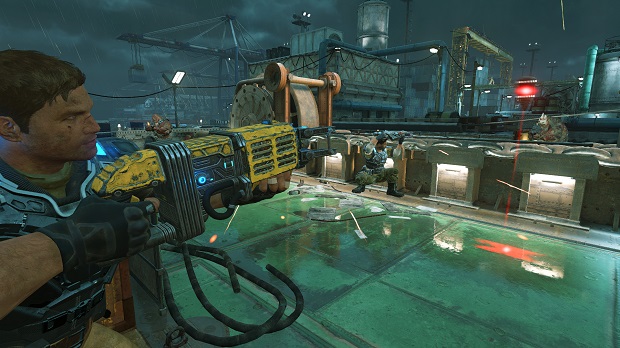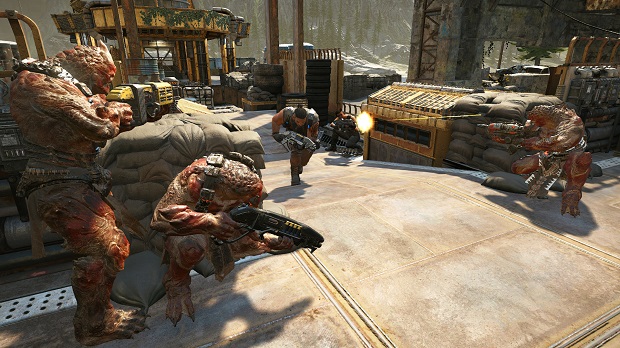A Closer Look at Escalation, Gears of War 4’s New Competitive Mode
What a weekend! Over the past few days, we’ve lifted the veil on what to expect from Gears of War 4 multiplayer – with our brand new multiplayer features trailer and a dedicated multiplayer panel at PAX East – alongside the incredible action of the Gears of War eSports Season 2 Finals.
What had us most excited of all was being able to finally show fans our new competitive game mode in Gears of War 4 during the eSports Season 2 Finals, known as Escalation. This mode was designed from the ground up for competitive gameplay, requiring coordinated team work and clutch plays when it matters most, as well as providing plenty of opportunity for the nail-biting finishes that both players and spectators expect from an eSports title.
Here’s what to expect from this brand new game mode when you play Escalation for yourselves this October.
Capture and Hold
At its core, Escalation is a round-based, ring-based objective mode with Execution rules. There are three rings on the map at all times – a middle ring an equal distance between both teams, and one ‘home’ ring for each team, which is placed in a more accessible location on the map. Team spawns do not move at any point during the round, though you will swap sides with the opposing team every second round.
Every second a team holds a ring earns them points towards the winning score limit – so holding two rings is the key to success. Rings take time to neutralize and capture, so controlling the areas of the map around a ring is just as important as capturing the ring itself. If all three rings are captured, Domination is achieved, instantly claiming round victory regardless of points scored. Achieving a Domination is a difficult feat, as the team will be stretched thin near the enemy spawn side – but the instant win reward and potential for clutch comebacks can make the risk worth it.
Strategic Weapon Placement
Escalation begins without any weapon pickups available on the battlefield. Unlike the rest of multiplayer modes offered in Gears of War 4, there are also no loadout selections available in Escalation – everyone starts with the Lancer and Gnasher to ensure every player in Escalation begins on an equal footing.
At the end of each round, the losing team can place a weapon onto the field – the location and weapon choices available are based on the usual weapon spawn locations for the map. These weapons are available for either team, so its essential teams strategize about which weapons to place and where – securing a placed weapon can be a massive boon for the team, but also presents the risk of potentially bolstering your opponent’s offense if they manage to win the fight for the weapon.

The most powerful weapons are available for placement in the central location, including the Dropshot and Boomshot. These weapons can have a major influence on the fight by providing a team a weapon that suits their strategy to turn the tide of battle. Just by their very presence on map, it can force the enemy team to change their strategy in order to not leave a free powerful weapon for the opposition to use.
In the non-central weapon spawn locations, you can select to spawn a Secondary Weapon. Selecting a Secondary Weapon slot will also provide a mirrored placement of the weapon on the other side of the map. These weapons – such as the Incendiary Grenades, Longshot and Boltok – support specific plays to counter an opponent’s strategy. The mirrored nature of this slot also means the enemy are also given easy access to this weapon, opening up new options and strategies for their team as well.
As an alternative strategy, you can use your weapon selection to block a weapon from being placed there. This decision can actually be a better play than placing a weapon at times, as it protects a part of a map your opponents are most effective in from becoming more impactful – should they lose a round and have their own chance to place a weapon.
Escalating Combat
True to its name, the combat in Escalation escalates round by round. In the first round, your individual respawn timer is set at a brisk 10 seconds, bringing dead players back into the fight quickly to rejoin the action. After each round, the respawn timer increases by 2 seconds, meaning each death becomes significantly more impactful as time goes on.

By Round 6, respawn times are 20 seconds, and each death can put a team on their heels almost instantly. This changes the pace from a usual ring objective based mode to something more akin to Execution, increasing the importance of Power Weapons and making every kill an opportunity to go on the offensive. Because of the Domination rule, a team that is multiple players down on longer respawn rounds is at a big risk of a sudden round loss, even if the other team is far behind on points.
After Round 6, half-time is declared and the process begins again – all weapons are removed from the map and the three objective rings are moved to new locations. If the match goes down to a Round 13 decider, each death will cause a huge 22 second wait to get back into the fight, producing some nail biting finishes to too-close-to-call matches of Escalation.
That’s all the basics of the new Escalation mode! If you missed the PAX Live Stream, you can watch our Escalation recap video above to see the mode in action using our brand new Spectator Mode functionality, built with our viewers in mind.
Let us know what you think of Escalation by tweeting @NodeZero on Twitter, and keep up to date on everything eSports by following @eSportsGears.
Thank you for all your amazing support during the Beta so far, and we can’t wait to play Escalation with you when Gears of War 4 releases on October 11, 2016!
